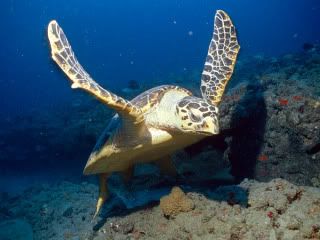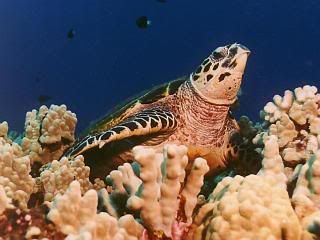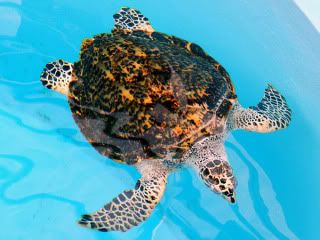Scientists made a recent discovery: a population of critically endangered Hawksbill turtles, thought to have been wiped out in the eastern Pacific from Mexico to Peru, has survived by occupying not their traditional coral reefs but a a new habitat ~ mangrove estuaries.
According to Alexander Gaos of Biology Letters, the finding is significant because it suggests that sea turtles can change to improve their odds of survival.
"We now know there are about 500 adult female Hawksbill turtles in at least four inland mangrove saltwater forests in El Salvador, Honduras, Nicaragua and Ecuador," Gaos said in an interview. "They are among the last remaining strongholds for this species."
Scientists have been working together with coastal villages, to "create community-based conservation programs," said Bryan Wallace, director of science and strategy for Conservation International's marine flagship species program. "All egg clutches are being relocated to hatcheries."
Prior to this discovery, it was believed that the species preferred open coasts and coral reefs in the Caribbean and Indo-Pacific regions. As recently as 2007, Hawksbill turtles were considered nearly extinct.
"It is possible that global climate change could, at some point in the future, drive marine turtles into estuaries such as these," Gaos said. "However, at this point, we do not believe that what we are seeing is a pattern that occurred over the past 20 to 30 years."
These findings support the results of a survey released last year, which showed the largest known rookeries of the turtle to be in El Salvador and Nicaragua.
The earliest reports of the Hawksbill turtle date to diaries of 18th century pirates and missionaries who chronicled the growth of "tortoiseshell" industries in northwest Mexico.
Cornerstoregoddess sea turtle jewelry
LA Times article.










Love your turtles! I won a turtle when I was very young with my brilliant contest name of ....Speedy. Speedy was a cute pet/friend until he was lost at sea. Well, OK he was lost in the creek behind our house. I still love turtles and especially yours! Thanks
ReplyDelete